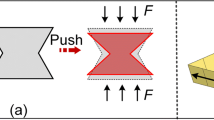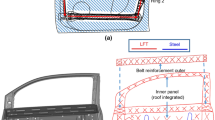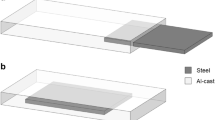Abstract
This paper presents a new one-body door impact beam that was developed to protect an occupant when a car is involved in a side collision. SPFC1180 Advanced High Strength Steel (AHSS) was used to improve the impact energy absorbability and the small door dent to ensure safety inside of the car. To obtain the proper closed cross section shape of the door impact beam, several designs with the same inside area were considered by conducting a finite element (FE) bending analysis using the ANSYS Mechanical software. FE door modeling was validated with the impact simulation package of the LS-DYNA software, and the results were compared to those from the door module test. The validated door beam model was also subjected to a side collision test of a complete vehicle following the FMVSS 214 regulation using a parallel computing simulation, and a comparison was carried out for the pipe-typed door beam using a virtual structural test applicability. The results indicate that the SPFC1180 one-body door impact beam can exhibit an equivalent reaction force and can decrease manufacturing costs and weight when compared to a pipe typed door beam as a result of the AHSS material, simple manufacturing process, and one-body closed-section shape design.
Similar content being viewed by others
Abbreviations
- ε :
-
true strain
- \(\dot \varepsilon \) :
-
strain rate
- σ :
-
yield stress
- C:
-
strain rate parameter
- d:
-
dynamic
- e:
-
engineering strain
- p:
-
strain rate parameter
- s:
-
static
References
Basavaraju, D. H., “Design and Analysis of a Composite Beam for Side Impact Protection of a Sedan,” M.Sc. Thesis, Department of Mechanical Engineering, Wichita State University, 2005.
Lee, H.-W., Hwang, J.-B., Kim, S.-U., Kim, W.-H., Yoo, S.-J., et al., “Construction of Vehicle Door Impact Beam using Hot Stamping Technology,” Transactions of the Korean Society of Mechanical Engineers A, vol. 34, no. 6, pp. 797–803, 2010.
Lim, T.S., “Mechanically Fastened Composite Side-Door Impact Beams for Passenger Cars Designed for Shear-out Failure Modes,” Composite structures, vol. 56, no. 2, pp. 211–221, 2002.
Im, J., Huh, H., and Kim, K., “Side Impact Analysis of an Auto-Body with 60trip Steel for Side Members,” Transactions of the Korean Society of Automotive Engineers, vol. 11, no. 2, pp. 164–171, 2003.
Yang, J.-H., “Optimization of the Aluminum Door Impact Beam Considering the Side Door Strength and the Side Impact Capability,” Journal of the Korea Academia-Industrial Cooperation Society, vol. 12, no. 5, pp. 2025–2030, 2011.
Song, J., So, B., Choi, H., Park, C., Cho, H., and Choi, S., “Automotive Door Impact Beam that have Durability and Conclusion Power Strengthening Structure,” KR Patent, no. 10-1326974–0000, 2013.
World Auto Steel, “Automotive Steel Definitions,” http://www. worldautosteelorg/steel-basics/automotive-steel-definitions/ (Accessed 27 AUG 2015)
Federal Motor Vehicle Safety Standards, “Side Impact Protection,” Crashworthiness, Standards no. 214, 2005.
Dassault Systemes, “CATIA Site,” http://www.3dscom/ko/productsservices/% 20catia/ (Accessed 27 AUG 2015)
ANSYS, “ANSYS Mechanical,” http://wwwansyscom/Products/ Simulation+Technology/Structural+Analysis/ANSYS+Mechanical (Accessed 8 DEC 2015)
Lin, C.-H., “Modeling and Simulation of Van for Side Impact Sensing Tests,” Proc. of 20th Enhanced Safety Vehicles Conference, 2007.
Livemore Software Technology Corporation, “LS-DYNA,” http:// wwwlstccom/ (Accessed 27 AUG 2015)
Livemore Software Technology Corporation, “LS-DYNA Keyword User’s Manual,” vol. 1, Version 971, 2007.
National Crash Analysis Center, “Applications-Finite Element Model Archive,” http://wwwncacgwuedu/vml/modelshtml (Accessed 27 AUG 2015)
Gyliene, V. and Ostasevicius, V., “Cowper-Symonds Material Deformation Law Application in Material Cutting Process using Ls-Dyna Fe Code: Turning and Milling,” Proc. of LS-DYNA® 8th European User’s Conference, pp. 1–12, 2011.
National Institute of Supercomputing and Networking, “Hardware Resources of KISTI Supercomputer,” http://wwwnisnrekr/kor/ actiondo?menuId=10010 (Accessed 22 DEC 2015)
Author information
Authors and Affiliations
Corresponding author
Rights and permissions
About this article
Cite this article
Yoon, T.H., Kim, H., Heo, C. et al. An experiment and FE simulation for the development of a SPFC1180 AHSS one-body door impact beam about a car side collision. Int. J. Precis. Eng. Manuf. 17, 81–89 (2016). https://doi.org/10.1007/s12541-016-0011-2
Received:
Accepted:
Published:
Issue Date:
DOI: https://doi.org/10.1007/s12541-016-0011-2




